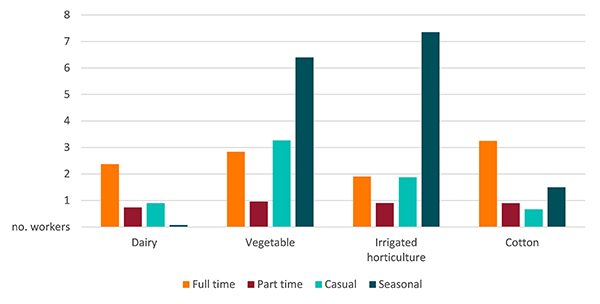Authors: Niki Dufty, Shiji Zhao, Walter Shafron and Haydn Valle
ABARES analysis of labour use in the dairy industry shows the industry has distinct labour force requirements and faces different challenges to the other industries. ABARES surveyed around 300 dairy farmers face-to-face in 2016 to collect data on farm physical and financial performance, labour use, recruitment experiences and future labour requirements.
The report complements results released previously for vegetable and irrigated horticulture and cotton farms (see Valle et al. 2017).
Key findings
- Dairy farms are estimated to have employed around 27,000 workers in 2015–16. The majority of these workers are family members or local residents employed on a full time or casual basis. In contrast with the vegetable, irrigated horticulture and cotton industries few seasonal workers are employed.
- Dairy farms are less labour intensive than vegetable, irrigated horticulture and cotton farms, generally employing fewer workers and spending less on labour costs. However, labour is still a very significant cost on dairy farms.
- There is a shift in the dairy industry towards large farm sizes. Large dairy farms tend to employ more workers, both skilled and unskilled, than smaller farms despite having a greater level of automation. These farms farm also use labour more productively.
- In the dairy industry, job vacancy rates and recruitment are low and more likely to occur to meet the need for labourers on a full time or casual basis. Few farms reported recruiting skilled workers in the previous year, possibly because of their reliance on family members to fill these more skilled positions.
- Among the farms that recruited workers in 2015–16, over 30 per cent experienced difficulties, most looking to fill full-time positions and citing issues associated with candidates’ poor attitude, motivation and personality as the main difficulty. The Department of Jobs and Small Business found a similar share of businesses reporting recruitment difficulties on average across all sectors of the economy (33 per cent).
- Dairy farmers identified the top three workforce difficulties they expect to experience in the future as: inadequate business profit to employ more workers (53 cent of farms); negative perception of the jobs in the industry (31 per cent of farms) and an ageing workforce (26 per cent of farms).

